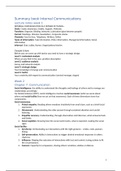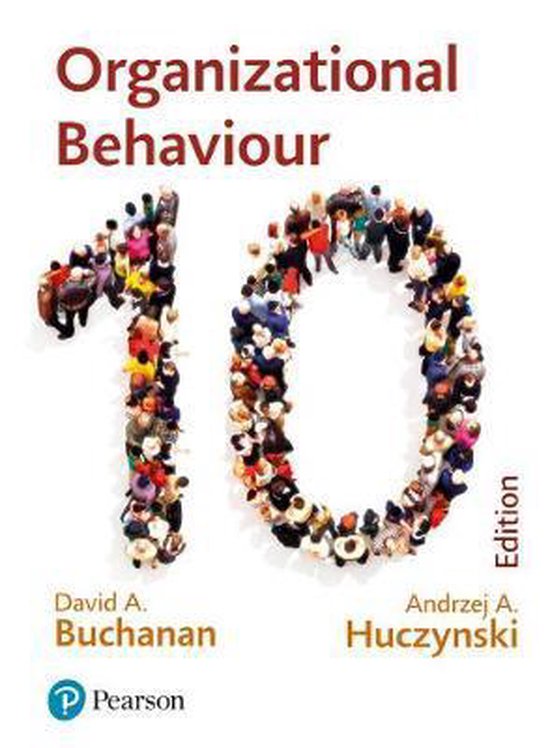Summary book Internal Communications
Lecture notes week 1
INTERNAL COMMUNICATION IS A MYRIAD OF THINGS…
Goals: Create awareness, Enable, Support, Motivate
Functions: Organize, Binding, Interpret, Lubrication (glue between people)
Formal: Meetings, Minutes, Newsletters, Corporate stories
Channels: Face-to-face, Telephone, Written, Online
Types of information: Task information, Policy information, Managerial information, Social
information
Informal: Chat, Lobby, Rumor, Organizational stories
Clampitt & Berk:
Before you can come up with tactics you need to have a strategic design.
Level 1: contextual analysis
What can you find in the case: problem description
Level 2: audience analysis
Survey and network analysis
Level 3: strategic design
Your knowledge of change and communication
Level 4: tactics
Your creativity with regard to communication (central message, slogan)
Week 2
Chapter 7: Communication
Social intelligence: the ability to understand the thoughts and feelings of others and to manage our
relationships accordingly.
For Danial Goleman (2007), social intelligence involves social awareness (what we sense about
others and social facility (how we act on that awareness). Each of these dimensions have four
components:
Social awareness:
1. Primal empathy: Reading others emotions intuitively from small clues, such as a brief facial
expression.
2. Attunement: Understanding the other person through sustained attention and careful
listening.
3. Empathic accuracy: Understanding, through observation and inference, what someone feels
and thinks.
4. Social cognition: Knowing how the social world works, what is expected, reading the social
signs.
Social facility:
1. Synchrony: Orchestrating our interactions with the right gestures – smiles, nods, posture,
timing
2. Self-preservation: Ability in interactions to trigger desired emotional responses in others,
charisma
3. Influence: Shaping the outcomes of interactions with tact and control, tuning actions to fit
the circumstances.
4. Concern: Capacity for compassion, sharing others’ emotions, elation or distress
1
,Interpersonal communication
Communication process: the transmission of information, and the exchange of meaning, between at
least two people.
Interpersonal communication: one-on-one or F2F (face to face) communication.
Coding: the stage in the interpersonal communication process in which the transmitter chooses how
to express a message for transmission to someone else.
Decoding: the stage in the interpersonal communication process in which the recipient interprets a
message transmitted to them by someone else.
Perceptual filters: individual characteristics, predispositions and preoccupations that interfere with
the effective transmission and receipt of messages.
Noise: factors outside the communication process which interfere with or distract attention from the
transmission and reception of the intended meaning.
Feedback: processes through which the transmitter of a message detects whether and how that
message has been received and decoded.
We assume that organisations function better where:
Communications are open
Relationships are based on mutual understanding and trust
Interactions are based on cooperation rather than competition
People work together in teams
Decisions are reached in a participative way
The main barriers to effective organizational communication are:
Power differences
Gender differences
Physical surroundings
Language
Cultural diversity
Verbal communication
Verbal means ‘in words’, which can be either spoken or written. Verbal agreement can thus refer to
oral or written communication and both are different from non-verbal communication.
Questioning techniques
Question type Illustration Uses
Closed Did you enjoy the movie? To get a yes or no answer; to get factual
information; to establish conversation control
Open What did you think of To introduce a subject; to encourage discussion; to
that movie? keep the other person talking
Probe Can you tell me more To follow up an open question; to get more
about that? information; to show interest
Reflective You thought the acting To show interest and concern; to encourage further
was poor? disclosure of feelings
Multiple What did you think of the Confuses the listener; gives them a choice of
movie, wasn’t the star question to which to respond
excellent, didn’t you think
that the ending was
predictable?
Leading You didn’t see anyone To get the answer that you expect to hear (so why
leave the house? ask?)
Hypothetical What would happen if..? To encourage creative thinking
Conversation controls
2
, Signal Example Meaning
Lubricators Uh huh; mmm, mmm and other grunts I’m listening, keep talking, I’m interested
and groans
Inhibitors What!; really; oh and similar loud I’m surprised, I don’t agree, I’ve heard
interjections enough of this
Bridges I’d like to leave that and move on to ask I’d like to make a clean link to the next
you conversation topic
Pauses (1) About two seconds silence In normal conversation: same as
lubricators
Pauses (2) Silence of three seconds or longer In a threat context: I’m going to wait until
I get an answer
Pauses (3) Silence of three seconds or longer In a counselling context: I’ll give you time
to think
Non-verbal behaviour
Non-verbal behaviour: the process of coding meaning through behaviours such as facial expressions,
limb gestures and body postures. It is also called body language.
We code and transmit factual information mainly through verbal communication. We code and
transmit feelings and emotions, and the strength of our feelings, through non-verbal communication.
There are 9 modes of non-verbal behaviour:
1. Kinesics: body movements; ex. Facial expressions, gestures, posture, etc.
2. Appearance: the way you look; ex. Dress, accessories, makeup, height, weight, etc.
3. Oculesics: with your eyes; ex. Eye contact, direction of gaze, blinking, pupil dilation, etc.
4. Haptics: through touch; ex. Types of touch, touch avoidance
5. Paralanguage: voice qualities (aka vocalics); ex. Pitch, volume, laughter, pauses, silence
6. Olfactics: smell; ex. Body odour, perfume, after shave
7. Proxemics: physical space; ex. Personal space, territory
8. Chronemics: through the use of time; ex. Talk time, speech rate
9. Environment and artefacts: through objects; ex. Build environment, design, landscape,
objects that say something about you
There are 5 functions of non-verbal behaviour:
1. To reveal your personal attributes: NVB sends signals about our personality, intentions and
attitudes.
2. To exercise social control and establish hierarchy: examples are talking and interrupting
more, eye contact, the pitch of your voice, facial expressions.
3. To promote social functioning: followership and social coordination can be encouraged
through nonverbal displays of competence, prestige and persuasion such as smiling.
4. To develop good relationships: NVB can help establish and maintain interpersonal
relationships, trust and commitment.
5. For emotional displays: we reveal our emotions through facial expressions, gestures and tone
of voice as well as verbally.
Proxemics: the way in which we use distance in relationships.
Open or positive non-verbal behaviour: turning your body towards someone, looking someone
straight in the face, establish eye contact, look away infrequently, nod and smile a lot and keeping
your hands and arms by your sides or in front of you.
3
, Closed or negative non-verbal behaviour: turning your body away, folding your arms tightly, crossing
your legs so that they point away from someone, loss of eye contact, wandering gaze, looking at
someone else or the door and a lack of nods and smiles.
Posture mirroring: group who is standing or sitting the same way.
Gesture mirroring: groups mirror each other’s gestures.
Power tells: non-verbal signals that indicate to others how important and dominant someone is, or
how powerful they would like us to think they are.
Cultural differences in communication styles
High context culture: a culture whose members rely heavily on a range of social and non-verbal clues
when communicating with others and interpreting their messages.
Low context culture: a culture whose members focus on the written and spoken word when
communicating with others and interpreting their messages.
You can reduce misunderstandings between high- and low context cultures by following 4 rules:
1. Assume that others are different
2. Use description and avoid evaluation
3. Practise empathy
4. Treat interpretations as working hypotheses
Impression management
Impression management: the processes through which we control the image or impression that
others have of us.
Front stage and back stage: front stage is the performance that we put on in our impression
management to others. Back stage: who we are when no one is watching.
Impression management is non-verbal and verbal communication
5 impression management tactics:
Tactics Used in order to be seen as But can instead be seen as
Ingratation: favours, Likeable Sycophantic (slijmerig)
conforming to others’
opinions, compliments
Self-promotion: boasting, Competent Braggart (opschepper)
taking credit
Exemplification: staying late at Dedicated Self-righteous (zelfingenomen)
work, appearing to be busy
Intimidation: making threats Threatening Bullying
Supplication: playing dumb Needy Incompetent
Research shows that observers respond more favourably to impression management tactics that are
consistent with gender stereotypes.
3 pieces of advice about the best way to manage impressions:
1. Emphasize your genuine qualities and avoid trying to signal traits, skills and competencies
that you don’t have.
2. Use impression management tactics in situations where this is appropriate.
3. Develop awareness of when and how often to manage your impressions.
4





